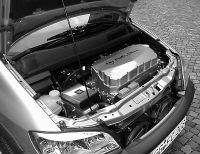Future powered by hydrogen
2000/12/10 Mendiburu, Joana - Elhuyar Zientziaren Komunikazioa
Wood was the kingdom of real energy until the industrial revolution. Coal came later and then it was oil and natural gas. Today, all energy companies are seriously working on finding substitutes to end fossil fuels in a mother. Due to environmental concerns, renewable energy has been received to the top of the substitutes, among which hydrogen is best appreciated by large companies.
Hydrogen fuel cells

Fuel cells work basically like batteries. The energy generated by combining hydrogen and oxygen is converted into electricity and the only waste generated is water vapor. That is, they produce energy in the same way as batteries but without polluting. However, both combustion engines and fuel cells must be fed externally.
The first steps in fuel cell preparation were taken in 1839 by Welsh physicist Willian Grove. The first practical cells were developed by the Americans for their space program. But technology is already on Earth and thanks to it, the future fueled by hydrogen has become more accessible. The fuel cell sector has known the revolution because a significant cost reduction has been achieved in the 1990s.
The world's largest energy producing companies and the automotive industry have already put their eyes on fuel cells. Because the former see hydrogen as a competitor of traditional energy sources and the latter as a very interesting option to fuel cars. Shell, for example, created in 1998 a department dedicated to hydrogen and sent a representative to the World Hydrogen Energy Congress held in Buenos Aires. Despite being one of the big companies currently working with oil, it has the most advanced plans for the post-oil era and has announced by 2050 a world that will cover half of the energy needs of renewable sources.
According to Shell, hydrogen will be the fuel of the future and will only be an intermediate solution.

The automobile industry does not want to be left behind either and most manufacturers have fuel cell research programs. This is because they work at low temperature and, due to their low incidence on the environment, they can be suitable to replace internal combustion engines. Daimler-Chrysler taught fuel cell powered buses from Chicago and Vancouver two years ago and was a success. It has been announced that the first buses and cars will circulate on European roads during 2002 and 2004. By then they want to prepare about 40,000 cars.
Difficulties
Vehicles that use fuel cells do not pollute and hardly generate noise. In that sense they are dreams. But you have to wake up from dreams and this is no exception. The costs of this technology remain high, there are difficulties to conserve hydrogen safely and it is yet to be discovered how to store enough hydrogen for long journeys. In fact, most of the time will be looking for suitable and cost-effective systems to transport and store hydrogen.

Therefore, methanol is often used as a raw material. Instead of powering the vehicle directly with hydrogen, methanol is added and then, as the car demands it, methanol becomes hydrogen. In addition to methanol, ethanol, natural gas and gasoline can perform the same function. However, this method does not prevent dependence on fossil fuels. In addition, hydrogen will be the protagonist of the future.
Experts believe that the direct passage from oil to hydrogen will be more expensive in the short term than the methanol - hydrogen oil route, but once the infrastructure is completed it will become more profitable. From an environmental point of view, a direct transition is considered more appropriate.
Production

Although hydrogen is natural in nature, it is scarce and there is no choice but to produce it through the transversal channels. In general, fossil fuels and water are the usual starting points. The most appropriate method is the use of water, a totally clean and renewable cycle: using water to produce hydrogen and producing water as waste. The reaction is effective but not economic. However, hydrogen extraction methods are expected to be more productive and economical soon.
Meanwhile, the cheapest way to produce hydrogen is by natural gas. In fact, today most of the hydrogen is produced by this method, mainly from methane. But this does not prevent dependence on fossil fuels or achieve a totally clean cycle, since although it is not polluted when burning does occur. Therefore, the use of renewable energies as a source of hydrogen is being promoted.
Iceland, the first pioneer
In northern Europe, an island almost lost in the Atlantic is at least one example of using renewable energy. Outside cities, 90% of households heat geothermal energy and in cities all. Meanwhile, 19% of electricity is produced by hydroelectric power. 99% of the Icelandic electrical system is based on renewable sources, mainly geothermal and hydroelectric, and 58% of the total energy system. When talking about the entire energy system, vehicles are also taken into account.
However, at an exemplary level, we cannot forget that Iceland has the advantage that many other countries do not have, that is, it has unbeatable natural resources as a renewable energy system is built. On the other hand, there is no oil or natural gas in Iceland, so a fossil fuel-based system would generate total dependence on the outside. For this reason, they have long been dedicated to the exploitation of their resources.

As for hydrogen, Iceland was the first and only state to commit to developing this energy source. In 1998 the world's leading companies in fuel cells and the Government of Iceland signed a contract for a national experiment. Participants included car manufacturer Daimler-Chrysler, oil company Shell, Norwegian hydroelectric company Norks Hydro and fuel cell designer Ballard Power System Vacouver. The goal is no less: They want to prepare Iceland that will run on hydrogen within 30 years.
For Iceland it is strategic to take the step and for the companies that have wanted to participate in the project, an extraordinary laboratory for the premiere of their ideas and prototypes. Trarnsio will remain especially in the field of transport, in which the dependence on fossil fuels is greater. For 30 years Iceland's public and private bus services vehicles and fishing fleet will also be powered by hydrogen. The gas stations will sell hydrogen and the shut-off tubes will only flow water. On the other hand, the possibility of exporting hydrogen produced there has also been taken into account. If this ambitious project pays off, who knows if Iceland will become North Kuwait?
Published in the supplement Natura de Gara

Gai honi buruzko eduki gehiago
Elhuyarrek garatutako teknologia





